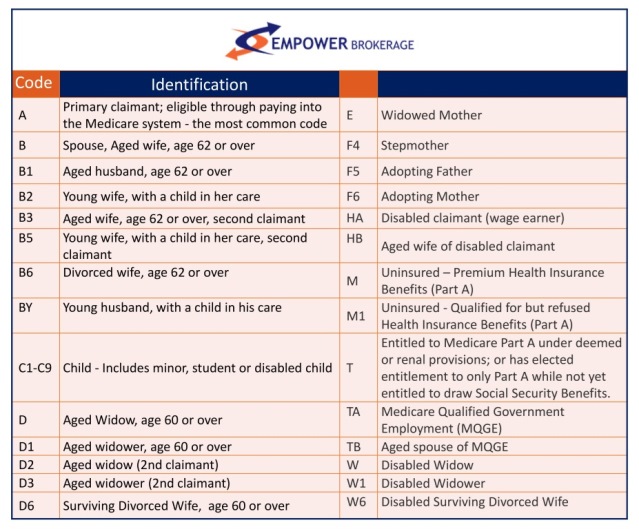You may have noticed a letter at the end of your Medicare number and wondered what it stands for.

This chart is not a comprehensive list of Medicare codes
Medicare Number Suffixes
After the numerical sequence, there will be a letter or a letter followed by another number. These codes indicate Medicare eligibility. For example, assume you are the wife (62 years or older) of the primary claimant, and your husband’s SSN is 555-55-5555. Your Medicare number would be 555-55-5555-B.
Below are some common Medicare codes and what they mean.
Relationships to the Primary Beneficiary Codes
The most common code is code “A”. This code indicates that the person is the primary beneficiary of Medicare. They are eligible for Medicare based on their own work history and contributions to the Medicare system (i.e., paying Medicare taxes for at least 40 quarters, or 10 years). This individual is the one whose Social Security Number (SSN) is on the Medicare card as the primary identifier.
Code “B” will appear on your form if you are married to or divorced from the primary beneficiary. This code shows that you are receiving Medicare benefits through your spouse’s (or ex-spouse’s) eligibility.
If you are the biological or adopted child of the primary beneficiary, Code “C” will appear on your Medicare card. Suffixes following “C” further specify your relationship to the primary beneficiary in terms of birth order. Suffixes following “C” indicate your relationship to the primary claimant. “C1” means you are the first child, “C2” means you are the second child, and so forth.
Eligibility due to Disability, or Special Circumstances
“H” indicates eligibility for Medicare due to a disability. “HA” will appear for the disabled claimant, while HB means you are the wife of a disabled claimant (62 or over). “HC” is for the child of a disabled claimant.
Codes “J” and “K” will indicate that you are a special beneficiary based on your work history or entitlement to Medicare Part A.
The codes at the end of your Medicare number are solely to indicate Medicare eligibility. The codes do not reflect what type of coverage you have enrolled in. If you are enrolled in Part A and/or Part B, this information will be on the front of your Medicare card under the heading “IS ENTITLED TO”. If you have enrolled in Medicare Part C (Medicare Advantage) or Part D (prescription drug coverage), this information will not appear anywhere on your Medicare card, but on a separate membership card that you receive after enrollment.
Got Medicare Questions?
We hope that this information on Medicare numbers is useful to you.
Let us help you answer your questions so that you can get back to the activities that you enjoy the most.
Call (888) 446-9157, click here to get an INSTANT QUOTE, or leave a comment below!
See our other websites:
This article was updated on October 28, 2025.

